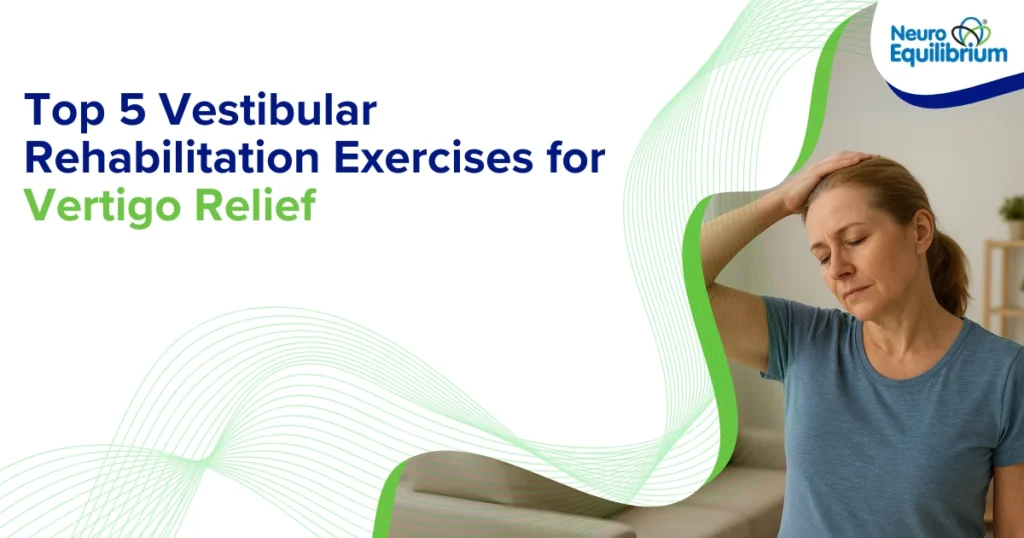Vertigo can really make everyday life unpredictable. One moment you’re feeling fine, and the next, the world seems to start spinning. This condition affects millions of people worldwide and can disrupt basic activities like walking, reading, and even lying down. While medication might help in some cases to ease symptoms, true long-term healing often comes from an alternative approach like vestibular rehabilitation exercises. These are part of a personalized program called Vestibular Rehabilitation Therapy (VRT), which helps the brain manage dizziness, improve balance, and restore stability. Some exercises provide quick relief, while others are slower but more effective in helping the body adapt and boosting confidence.
In this blog, we’ll try and explore the top five exercises for vestibular rehabilitation that can help relieve vertigo. We’ll also highlight the importance of modern technology, answer common questions, and show how professional care can make all the difference in achieving success.
What Is Vestibular Rehabilitation Therapy (VRT)?
The inner ear possesses a system in charge of balance which stabilizes vision as the head rotates, the vestibular system. The brain obtains incorrect signals regarding the motion when it fails to work because of the presence of disorders such as Benign Paroxysmal Positional Vertigo (BPPV), Meniere’s disease, neuritis of the vestibular apparatus, or the traumatic experiences this results in symptoms such as dizziness, imbalance and at times nausea..
Vestibular rehabilitation exercises help by:
- Treatment of mechanical inner ear diseases (like dislocated crystals in BPPV).
- Reflex training in order to stabilize vision.
- Developing resilience to reasons that cause dizziness.
- Increasing strength and decreasing falls risk.
Vestibular rehabilitation is very specific, unlike general exercise, and tailor-made to the exact condition of the patient.
Know More About Vestibular Health
- 10 Early Signs You Might Have a Vestibular Disorder
- How Juggling Enhances the Balance System
- 5 Questions to Ask Your Doctor Before Vestibular Testing

1. Epley’s Maneuver (Canalith Repositioning Maneuver)
Function: To transport out of the semicircular canals and into the utricle the displaced crystals of calcium carbonate (otoliths), where they are located.
How it works: The head and the body of the patient are brought through a series of positions. These regulated motions move the crystals back to their positions, preventing them from transmitting false signals.
Relief: Relief is immediate in many patients. Symptoms disappear in a few minutes after the maneuver to some. It may require repetitions by other peopleperformed only with the assistance of a doctor.
2. Gaze Stabilization Exercises
Purpose: To recondition Vestibulo-Ocular Reflex (VOR) that stabilizes the eyes as the head turns.
How it works:The patient focuses on a fixed point (like a letter on the wall) while moving the head side to side or up and down. Movements are then increasingly complicated and faster with time.
Application: These are exercises that are particularly relevant when the patient feels dizzy when making a movement or experiences blurred vision when walking or reading.
Advantage: Vision stabilizes even when on motion. Everyday activities like crossing roads, walking upstairs or turning are simplified and less risky.
3. Habituation Exercises
Purpose: To reduce dizziness triggered by specific movements through repeated exposure.
How it works: The patient repeatedly performs movements that trigger mild dizziness, which include rolling in bed, turning head, sitting up and lying down. The brain also becomes used to it and it no longer overreacts.
Examples:
- Lying down and sitting up repeatedly
- Rolling side to side in bed
- Bending forward while seated
Benefit: Over time, movements that once caused spinning become more tolerable, and one becomes less anxious about day to day activities.
4. Balance Training (Postural Stability Exercises)
Purpose: To enhance balance and decrease the risk of falling.
Its mechanics: The patients train standing and walking under difficult conditions. This can involve standing on foam pads, walking heel-to-toe or walking balancing with eyes shut. Uneven surfaces or balance boards can also be used.
Application: The training is significant to older adults and those who experience a sense of instability. It can also be employed in the athletes who have experienced a recovery after having vestibular issues.
Benefit: Balance training helps to regain confidence and leave patients feeling safer when walking outside, going through crowded places, or exercising.
5. Repositioning Maneuvers for Horizontal Canal BPPV
Purpose: To treat horizontal canal BPPV, a less common form of the condition.
Key maneuvers:
- Barbecue Roll: The patient lies on his back and turns the head in 90 degree steps to complete the turning of the head.
- Zuma Maneuver: The patient sits in a lateral position of 30-60 seconds and then sits back up.A
Relief: These maneuvers can quickly resolve dizziness when properly performed.
Application: A skilled specialist should make a correct diagnosis Also it is performed under supervised conditions of an expert only, as horizontal BPPV is not treated with the same maneuvers as the posterior BPPV.

The Role of Modern Technology in Vestibular Rehabilitation
Traditional exercises are highly effective, but modern technology has made vestibular rehabilitation more engaging and precise.
- Virtual Reality (VR): Patients train balance in secure simulated situations like walking on a thin beam or walking on lines.
- Dynamic Functional Training: This involves walking with head turning, stair climbing or walking on various surfaces.
- Creative Activities: Engaging in simple activities like juggling not only requires vision, coordination, and balance but also adds a fun and engaging element to the therapy process thereby making it interesting.
Technology also makes patients remain motivated and enables the therapists to have accurate feedback on progress.
Taking the Next Step with NeuroEquilibrium
Vertigo can take away your confidence and independence, but it can be cured. Vestibular rehabilitation interventions, such as Epley maneuver, gaze stabilization, habituation, balance, and repositioning maneuvers (horizontal BPPV) are known procedures that help to achieve relief and stabilization. Through practice and guidance, a lot of patients go back to their lives without the fear of dizziness that will always be on their minds.
At NeuroEquilibrium, we are experts in the diagnosis and treatment of the vestibular conditions using modern technology and individual attention. We will create individualized vestibular rehabilitation plans to meet the needs of individual patients. Whether you’re seeking quick relief from BPPV or long-term stability after chronic dizziness, we can help you regain balance and confidence.Don’t wait if vertigo is affecting your daily life. Get in touch with NeuroEquilibrium to start your path to recovery.
Can vestibular rehabilitation exercises cure vertigo?
They have the ability to treat vertigo that occurs as a result of inner ear crystal displacement (BPPV), and significantly alleviate the symptoms in other disorders. Although they are not in all cases a long-term cure, they tend to be very effective and bring back stability.
How long does it take to feel better with these exercises?
Patients with BPPV often experience immediate improvement after the Epley maneuver. Others, particularly those who undergo gaze stabilization or habituation, might require a number of weeks of regular practice before they start noticing gradual improvement. The exercises vary according to the diagnosis and the underlying cause of dizziness.
Can I do these exercises at home?
Yes, a great number of vestibular rehabilitation exercises may be carried out at home, yet it is better to learn them first with the assistance of a trained specialist. The wrong exercise or wrong technique may occasionally aggravate the symptoms.
Are these exercises safe for older adults?
Yes. Balance training is, in fact, especially useful in older adults, as it helps them to minimize the chance of falls. Supervision is recommended, especially in the initial stages.
What if exercises make me feel more dizzy at first?
Habituation exercises are likely to result in mild dizziness. This dizziness tends to reduce with time as the mind becomes used to it. In case of serious or chronic symptoms, the doctor would be summoned.















